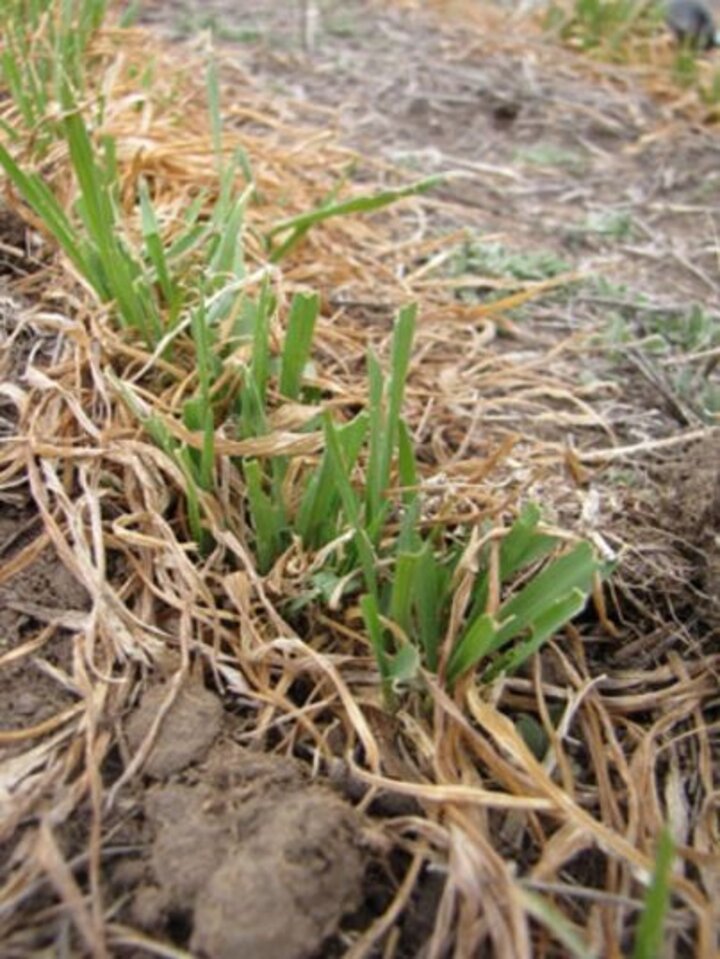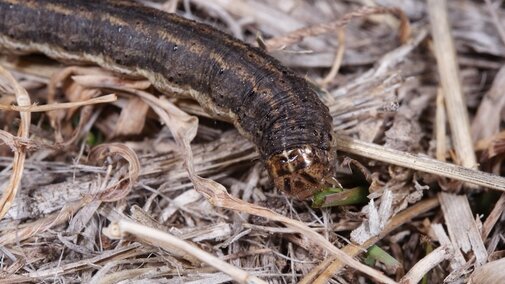Army cutworms have been spotted in Kansas and Nebraska crop fields this month. This is an important time to scout for this pest, particularly in wheat and alfalfa. Of the many cutworm species in Nebraska, the army cutworm is the most damaging in western Nebraska. Economic damage from other cutworms, such as the pale western cutworm, dark-sided cutworm and variegated cutworm, is rare. The army cutworm damages alfalfa, wheat, sugarbeet, canola, and various rangeland grasses. There have also been reports of army cutworm feeding on pulse crop seedlings, such as field peas and chickpeas.
How Army Cutworm Caterpillars Spend the Winter
Because army cutworms overwinter in Nebraska as larvae in the soil, they are one of the first caterpillars to be seen in the spring. Last year, in late September and October, army cutworm moths laid their eggs (females are capable of laying 1,000-3,000 eggs) directly on bare soil, such as in newly planted winter wheat or heavily grazed patches of range. After rainfall, these eggs hatched over an extended period, leading to a variety of caterpillar sizes that continued feeding and developing as long as temperatures were adequate (approximately higher than 45°F). When the weather turned colder, the caterpillars burrowed down into the soil to spend the winter. Now, caterpillars are emerging from the soil on warmer days to feed (Figure 1).
However, scouting fields for this insect now and in the coming days could be good prevention.
Army Cutworm Adults are Miller Moths
In 2019, moderate populations of the adult army cutworm moth (or "miller moth") could be found in sheltered areas during the day in some locations in western Nebraska. Although, very low numbers were observed in Scottsbluff and North Platte. In fact, army cutworm populations have been quite low for the past five years. Our last large populations of larvae occurred in 2012 and high populations in turn contributed to patchy populations above threshold in spring 2013 and 2014. That said, it will still be important to scout fields now and as we continue into April and wheat breaks dormancy.
Army cutworm larvae are greenish-brown to greenish-grey caterpillars, approximately ½ to 2 inches in length (Figure 1).
Feeding damage from army cutworm larvae can vary from grazing leaf tips and chewing on the sides of wheat seedlings (Figure 2 and 3) to complete stand reduction. In infested fields, you may see higher than usual bird activity, especially in the early morning; birds will often feed on army cutworm larvae when they are in high numbers.


Scouting and Treatment Recommendations
To scout for army cutworms, use a treatment threshold of 4 or more cutworm larvae per square foot of winter wheat or alfalfa. However, for stressed, thin stands of wheat or newly established alfalfa stands, use a threshold of 2 or more larvae per square foot. New or stressed alfalfa stands (for example, stands that suffered from some winterkill) require a lower threshold because they are more prone to damage from cutworms.
Army cutworms only feed at night and seek out dark, sheltered areas during the day. Turn over clots of loose soil and residue for accurate cutworm counts.
If army cutworm counts are above the threshold, consider an insecticide application.

Please refer to the 2020 Guide for Weed, Disease, and Insect Management in Nebraska, EC130 for current insecticide use information in wheat and alfalfa. Always read pesticide instructions carefully before use.

